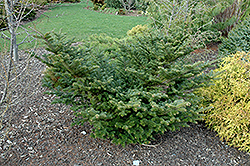Klein's Nest Fraser Fir
Abies fraseri 'Klein's Nest'
Height: 4 feet
Spread: 5 feet
Sunlight:
![]()
![]()
Hardiness Zone: 4
Other Names: Southern Fir
Description:
A very slow growing variety with a low spreading habit; branches are covered with short medium green needles; an excellent garden accent; avoid windy, dry sites
Ornamental Features
Klein's Nest Fraser Fir is a dwarf conifer which is primarily valued in the landscape or garden for its ornamental upright and spreading habit of growth. It has rich green evergreen foliage which emerges bluish-green in spring. The needles remain green throughout the winter. The purple fruits are held in cones from late summer to early fall.
Landscape Attributes
Klein's Nest Fraser Fir is a multi-stemmed evergreen shrub with an upright spreading habit of growth. Its average texture blends into the landscape, but can be balanced by one or two finer or coarser trees or shrubs for an effective composition.
This is a relatively low maintenance shrub, and usually looks its best without pruning, although it will tolerate pruning. It has no significant negative characteristics.
Klein's Nest Fraser Fir is recommended for the following landscape applications;
- Accent
- General Garden Use
Planting & Growing
Klein's Nest Fraser Fir will grow to be about 4 feet tall at maturity, with a spread of 5 feet. It has a low canopy. It grows at a slow rate, and under ideal conditions can be expected to live for 70 years or more.
This shrub does best in full sun to partial shade. It prefers to grow in moist to wet soil, and will even tolerate some standing water. It is particular about its soil conditions, with a strong preference for sandy, acidic soils. It is quite intolerant of urban pollution, therefore inner city or urban streetside plantings are best avoided, and will benefit from being planted in a relatively sheltered location. Consider applying a thick mulch around the root zone in winter to protect it in exposed locations or colder microclimates. This is a selection of a native North American species.
